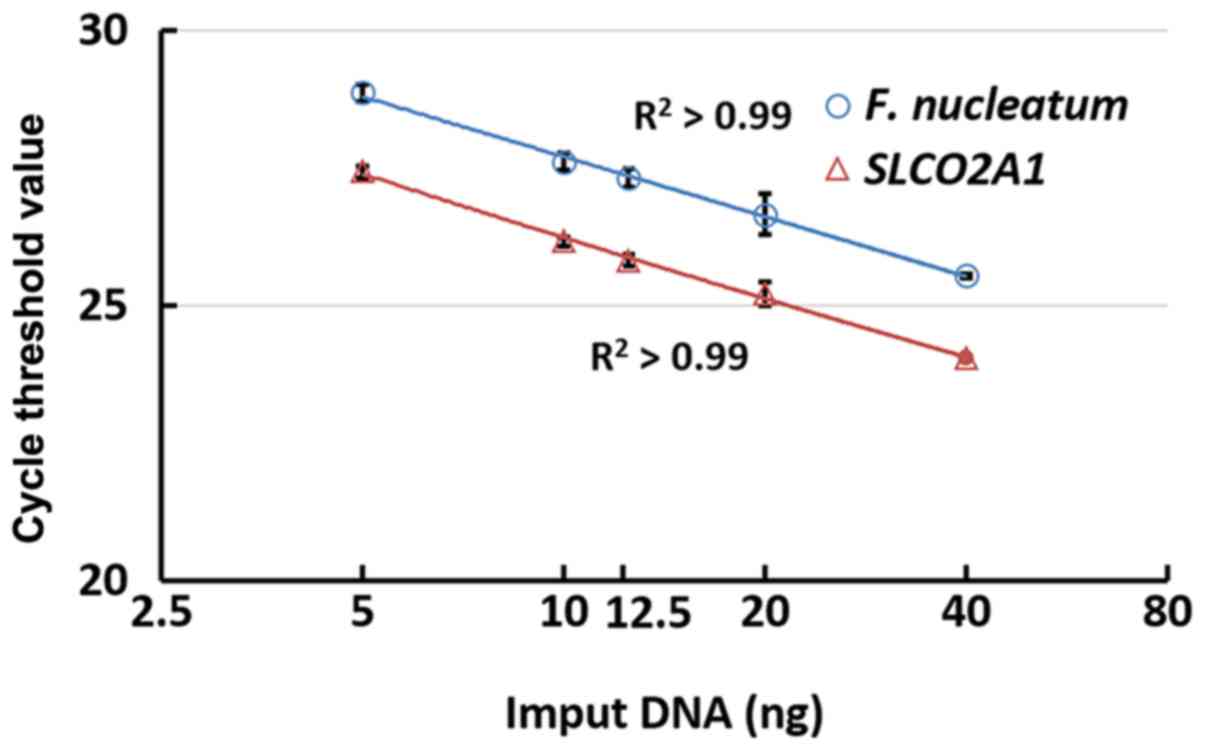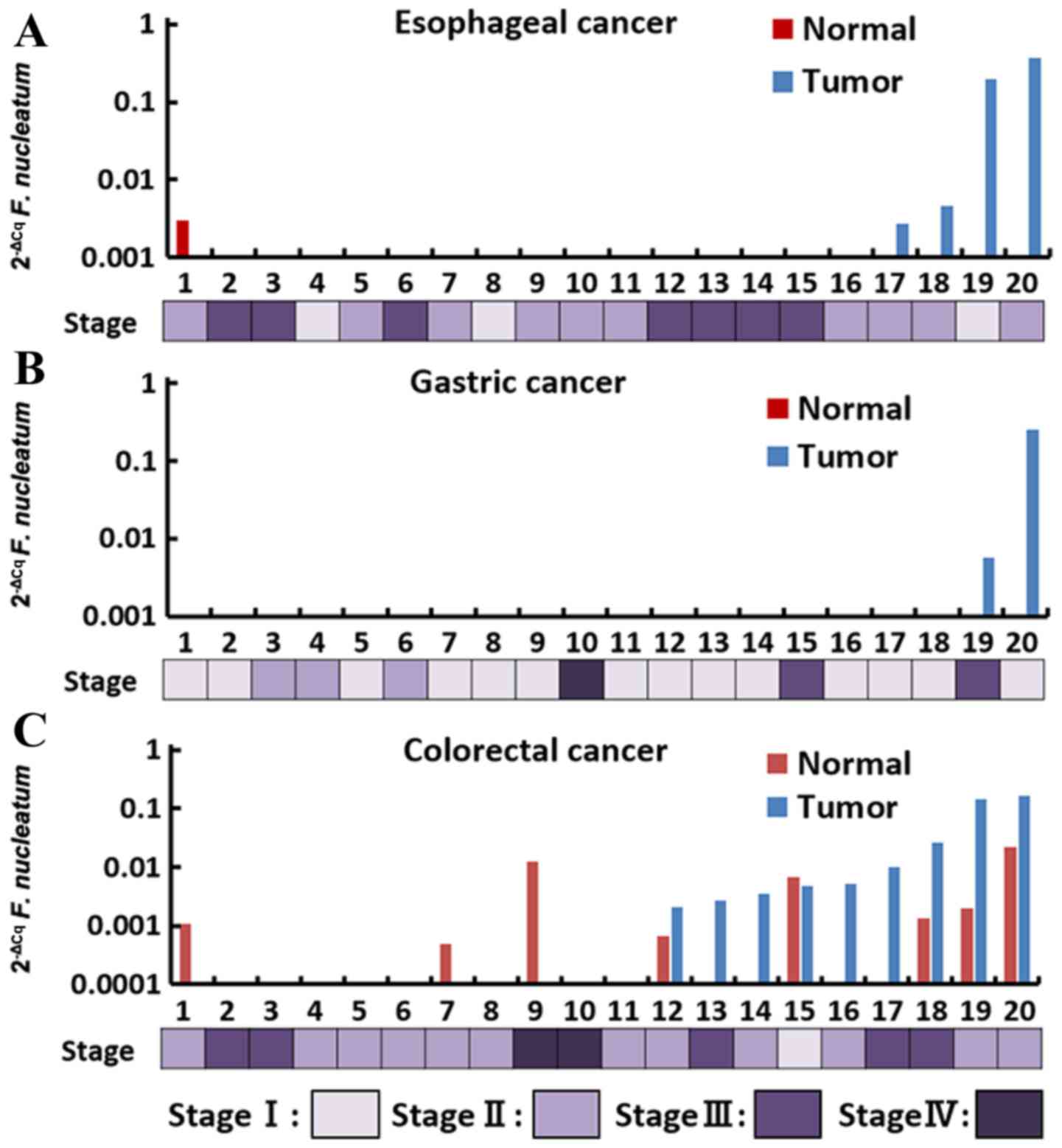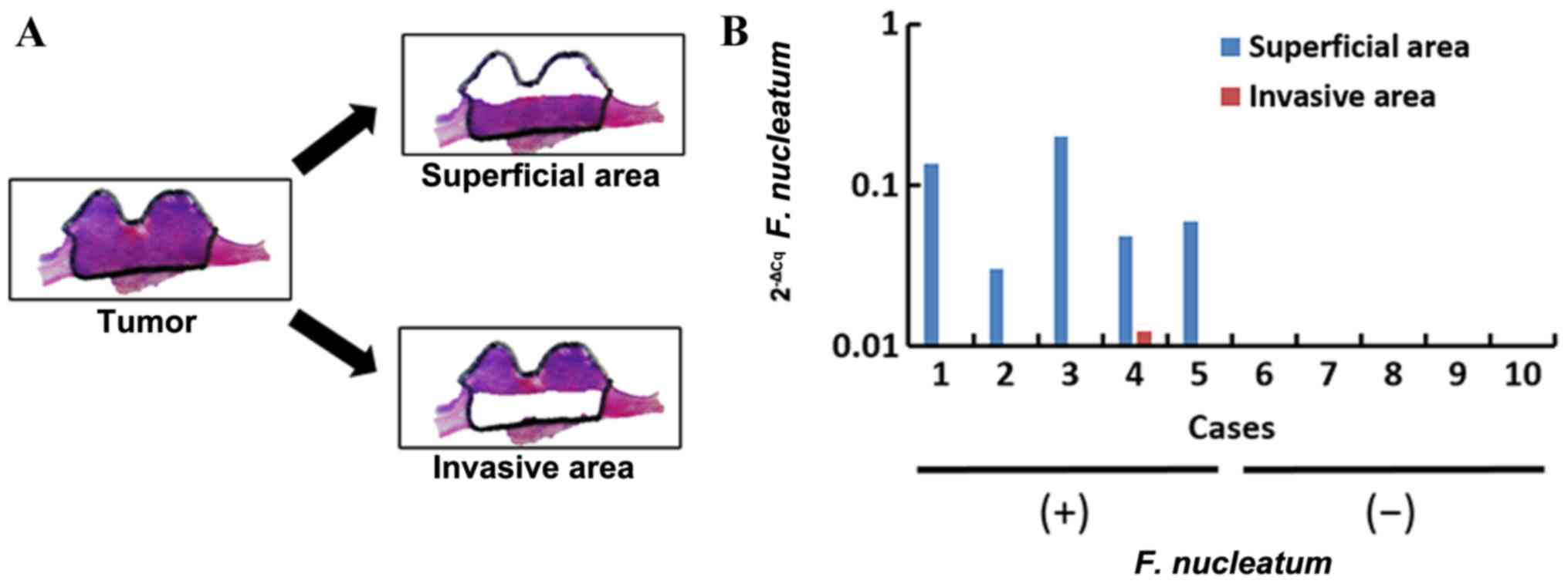|
1
|
Griffen AL, Beall CJ, Campbell JH,
Firestone ND, Kumar PS, Yang ZK, Podar M and Leys EJ: Distinct and
complex bacterial profiles in human periodontitis and health
revealed by 16S pyrosequencing. ISME J. 6:1176–1185. 2012.
View Article : Google Scholar : PubMed/NCBI
|
|
2
|
Loozen G, Ozcelik O, Boon N, De Mol A,
Schoen C, Quirynen M and Teughels W: Inter-bacterial correlations
in subgingival biofilms: A large-scale survey. J Clin Periodontol.
41:1–10. 2014. View Article : Google Scholar : PubMed/NCBI
|
|
3
|
Feng X, Zhang L, Xu L, Meng H, Lu R, Chen
Z, Shi D and Wang X: Detection of eight periodontal microorganisms
and distribution of Porphyromonas gingivalis fimA genotypes in
Chinese patients with aggressive periodontitis. J Periodontol.
85:150–159. 2014. View Article : Google Scholar : PubMed/NCBI
|
|
4
|
Liu P, Liu Y, Wang J, Guo Y, Zhang Y and
Xiao S: Detection of fusobacterium nucleatum and fadA adhesin gene
in patients with orthodontic gingivitis and non-orthodontic
periodontal inflammation. PLoS One. 9:e852802014. View Article : Google Scholar : PubMed/NCBI
|
|
5
|
Ohkusa T, Okayasu I, Ogihara T, Morita K,
Ogawa M and Sato N: Induction of experimental ulcerative colitis by
Fusobacterium varium isolated from colonic mucosa of patients with
ulcerative colitis. Gut. 52:79–83. 2003. View Article : Google Scholar : PubMed/NCBI
|
|
6
|
Minami M, Ando T, Okamoto A, Sasaki N,
Ohkura T, Torii K, Hasegawa T, Ohta M and Goto H: Seroprevalence of
Fusobacterium varium in ulcerative colitis patients in Japan. FEMS
Immunol Med Microbiol. 56:67–72. 2009. View Article : Google Scholar : PubMed/NCBI
|
|
7
|
Tahara T, Shibata T, Kawamura T, Okubo M,
Ichikawa Y, Sumi K, Miyata M, Ishizuka T, Nakamura M, Nagasaka M,
et al: Fusobacterium detected in colonic biopsy and
clinicopathological features of ulcerative colitis in Japan. Dig
Dis Sci. 60:205–210. 2015. View Article : Google Scholar : PubMed/NCBI
|
|
8
|
Strauss J, Kaplan GG, Beck PL, Rioux K,
Panaccione R, Devinney R, Lynch T and Allen-Vercoe E: Invasive
potential of gut mucosa-derived Fusobacterium nucleatum positively
correlates with IBD status of the host. Inflamm Bowel Dis.
17:1971–1978. 2011. View Article : Google Scholar : PubMed/NCBI
|
|
9
|
Song YG, Shim SG, Kim KM, Lee DH, Kim DS,
Choi SH, Song JY, Kang HL, Baik SC, Lee WK, et al: Profiling of the
bacteria responsible for pyogenic liver abscess by 16S rRNA gene
pyrosequencing. J Microbiol. 52:504–509. 2014. View Article : Google Scholar : PubMed/NCBI
|
|
10
|
Yoneda M, Kato S, Mawatari H, Kirikoshi H,
Imajo K, Fujita K, Endo H, Takahashi H, Inamori M, Kobayashi N, et
al: Liver abscess caused by periodontal bacterial infection with
Fusobacterium necrophorum. Hepatol Res. 41:194–196. 2011.
View Article : Google Scholar : PubMed/NCBI
|
|
11
|
Bohrer JC, Kamemoto LE, Almeida PG and
Ogasawara KK: Acute chorioamnionitis at term caused by the oral
pathogen Fusobacterium nucleatum. Hawaii J Med Public Health.
71:280–281. 2012.PubMed/NCBI
|
|
12
|
Castellarin M, Warren RL, Freeman JD,
Dreolini L, Krzywinski M, Strauss J, Barnes R, Watson P,
Allen-Vercoe E, Moore RA, et al: Fusobacterium nucleatum infection
is prevalent in human colorectal carcinoma. Genome Res. 22:299–306.
2012. View Article : Google Scholar : PubMed/NCBI
|
|
13
|
Kostic AD, Gevers D, Pedamallu CS, Michaud
M, Duke F, Earl AM, Ojesina AI, Jung J, Bass AJ, Tabernero J, et
al: Genomic analysis identifies association of Fusobacterium with
colorectal carcinoma. Genome Res. 22:292–298. 2012. View Article : Google Scholar : PubMed/NCBI
|
|
14
|
Rubinstein MR, Wang X, Liu W, Hao Y, Cai G
and Han YW: Fusobacterium nucleatum promotes colorectal
carcinogenesis by modulating E-cadherin/beta-catenin signaling via
its FadA adhesin. Cell Host Microbe. 14:195–206. 2013. View Article : Google Scholar : PubMed/NCBI
|
|
15
|
Tahara T, Yamamoto E, Suzuki H, Maruyama
R, Chung W, Garriga J, Jelinek J, Yamano HO, Sugai T, An B, et al:
Fusobacterium in colonic flora and molecular features of colorectal
carcinoma. Cancer Res. 74:1311–1318. 2014. View Article : Google Scholar : PubMed/NCBI
|
|
16
|
Mima K, Sukawa Y, Nishihara R, Qian ZR,
Yamauchi M, Inamura K, Kim SA, Masuda A, Nowak JA, Nosho K, et al:
Fusobacterium nucleatum and T cells in colorectal carcinoma. JAMA
Oncol. 1:653–661. 2015. View Article : Google Scholar : PubMed/NCBI
|
|
17
|
Flanagan L, Schmid J, Ebert M, Soucek P,
Kunicka T, Liska V, Bruha J, Neary P, Dezeeuw N, Tommasino M, et
al: Fusobacterium nucleatum associates with stages of colorectal
neoplasia development, colorectal cancer and disease outcome. Eur J
Clin Microbiol Infect Dis. 33:1381–1390. 2014. View Article : Google Scholar : PubMed/NCBI
|
|
18
|
Mima K, Nishihara R, Qian ZR, Cao Y,
Sukawa Y, Nowak JA, Yang J, Dou R, Masugi Y, Song M, et al:
Fusobacterium nucleatum in colorectal carcinoma tissue and patient
prognosis. Gut. 65:1973–1980. 2016. View Article : Google Scholar : PubMed/NCBI
|
|
19
|
Ito M, Kanno S, Nosho K, Sukawa Y,
Mitsuhashi K, Kurihara H, Igarashi H, Takahashi T, Tachibana M,
Takahashi H, et al: Association of Fusobacterium nucleatum with
clinical and molecular features in colorectal serrated pathway. Int
J Cancer. 137:1258–1268. 2015. View Article : Google Scholar : PubMed/NCBI
|
|
20
|
Mitsuhashi K, Nosho K, Sukawa Y, Matsunaga
Y, Ito M, Kurihara H, Kanno S, Igarashi H, Naito T, Adachi Y, et
al: Association of Fusobacterium species in pancreatic cancer
tissues with molecular features and prognosis. Oncotarget.
6:7209–7220. 2015. View Article : Google Scholar : PubMed/NCBI
|
|
21
|
Viljoen KS, Dakshinamurthy A, Goldberg P
and Blackburn JM: Quantitative profiling of colorectal
cancer-associated bacteria reveals associations between
fusobacterium spp., enterotoxigenic Bacteroides fragilis (ETBF) and
clinicopathological features of colorectal cancer. PLoS One.
10:e01194622015. View Article : Google Scholar : PubMed/NCBI
|
|
22
|
Compton CC, Byrd DR, Garcia-Aguilar J,
Kurtzman SH, Olawaiye A and Washington MK: The AJCC cancer staging
atlas. 2nd edition. Springer; New York, NY: 2012, View Article : Google Scholar
|
|
23
|
Livak KJ and Schmittgen TD: Analysis of
relative gene expression data using real-time quantitative PCR and
the 2-ΔΔCT method. Methods. 25:402–408. 2001. View Article : Google Scholar : PubMed/NCBI
|
|
24
|
Field CA, Gidley MD, Preshaw PM and
Jakubovics N: Investigation and quantification of key periodontal
pathogens in patients with type 2 diabetes. J Periodontal Res.
47:470–478. 2012. View Article : Google Scholar : PubMed/NCBI
|
|
25
|
Do H and Dobrovic A: Dramatic reduction of
sequence artefacts from DNA isolated from formalin-fixed cancer
biopsies by treatment with uracil-DNA glycosylase. Oncotarget.
3:546–558. 2012. View Article : Google Scholar : PubMed/NCBI
|
|
26
|
Sah S, Chen L, Houghton J, Kemppainen J,
Marko AC, Zeigler R and Latham GJ: Functional DNA quantification
guides accurate next-generation sequencing mutation detection in
formalin-fixed, paraffin-embedded tumor biopsies. Genome Med.
5:772013. View
Article : Google Scholar : PubMed/NCBI
|













